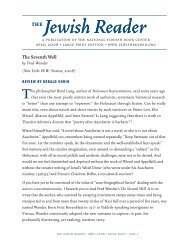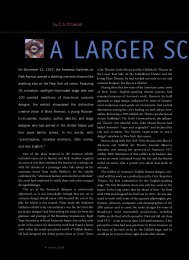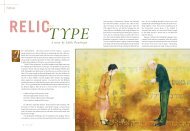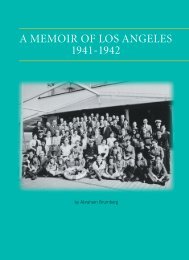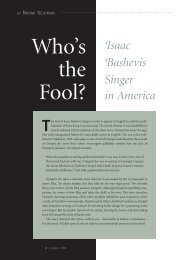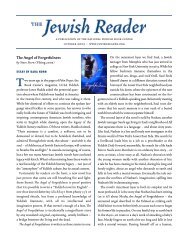Holiday Cheer - Yiddish Book Center
Holiday Cheer - Yiddish Book Center
Holiday Cheer - Yiddish Book Center
You also want an ePaper? Increase the reach of your titles
YUMPU automatically turns print PDFs into web optimized ePapers that Google loves.
y JENNA WEISSMAN JOSELIT<strong>Holiday</strong> <strong>Cheer</strong>Acentury ago, the advent of the Jewish New Yearprompted a flurry of activity in Jewish communitiesacross the United States. SomeAmerican Jews, manifesting a sudden “shiver of religiosity,”purchased tickets to religious services; othersmarked the occasion with a new hat and still others – lotsof them, it seems – exchanged greeting cards. A newminhag or custom, the distribution of shana tovas, asJewish New Year cards were commonly called, tookAmerican Jewry by storm at the turn of the twentieth centurywhen neighbors vied with one another in sending outthe most cards or the very latest ones.Given the novelty of the practice, the exchange ofJewish greeting cards also entangled American Jews in athicket of do’s and don’ts.“New Year presents the same difficultyas the issue of wedding invitations,” observed theAmerican Hebrew, one of the nation’s leading Jewish newspapers,in 1905. “We have to debate where we can safelydraw the line, with whom we are so intimate that we neednot send cards, with whom we are sufficiently distant thatwe can forget to mail a greeting and who is so punctiliousthat the non-receipt of [a card] will make him or her oursworn enemy for life.”Widely available and affordable, shana tovas could bebought at any number of venues, from pushcart vendorsand “Ghetto stationers” to fancy department stores such asWanamaker’s, which carried the item on its main floor. In1913, for instance, “novelty cards” could be had for anywherefrom six to eighteen cents apiece, postcards for apenny, while personal greeting cards “with your own nameand address” ranged from twenty to forty cents.8 SUMMER 2003
Jewish New Year Cards9 PAKN TREGER
Photographs by Jim Gipe.Eager consumers could also purchase the cards directly from the Hebrew Publishing Companyand its competitors, Bloch Publishing Company and the Williamsburg Art Company. All threecompanies functioned as both manufacturers and distributors.Much like their recipients, Jewish greeting cards came in various kinds of shapes, sizes, and sensibilities,from the modest, self-contained square of a penny postcard to an oversized, eight-by-eleven-inchrectangle, accented with all manner of furbelows and frills. Some cards were the very picture of restraint:quick and to the point, they eschewed ornamentation in favor of a simple message in Hebrew andEnglish: “L’shana tova tikasavu. A happy New Year.” Others trafficked in the sweet and sappy. (“If we maynot be sentimental on Rosh Hashanah when, indeed, shall we?” wondered one well-wisher on the eve ofWorld War I.) Featuring amber-hued scenes of a multi-generational family sitting down to a yontefdikedinner or performing the ritual of tashlikh, they offered a vision of Jewish life untainted by time.Still other shana tovas, “multi-colored pasteboard creations, frosted and be-ribboned,” reveled indetail, in riotous combinations of motifs, colors, and materials such as accordion pleats and paperhinges which allowed the images to pop up and open out in all their three-dimensional glory. Visuallyarresting and compelling, these cards were meant to be displayed proudly on a mantelpiece, where theycould be seen by one and all, instead of pasted onto the leaves of an album or casually discarded.With the exception of the actual greeting stamped on the cover or within its folds, little distinguishedJewish greeting cards from their non-Jewish counterparts, most of which were published inGermany, the premier source for color printing. Vivid examples of chromolithography, the “democraticart” of the late nineteenth and early twentieth centuries, they not only shared a penchant for10 SUMMER 2003
sweetfaced angels, gliding swans, and bouquets of dainty flowers but also fancied the same palette,which ran to cerulean blues and cheery pinks. At times, these similarities occasioned grumbling. “Alasand alack! ’Tis little originality that meets the eye,” complained Gabriel Costa, writing in the pages ofthe American Hebrew in 1913.This was no accident. Shana tovas were often barely more than Judaized versions of Christmas,Easter, and St. Valentine’s Day cards. Manufacturers, drawing on “remnants,” were all too happy torecycle last year’s stock for the delectation of Jewish consumers. All it took was the nimble insertion ofa <strong>Yiddish</strong> word here and a Hebrew word there or the addition of a Jewish star, a sefer torah, or the blueand-whiteJewish flag to transform a manifestly non-Jewish product (“loving wishes to my sweetheart”)into one suffused with Jewish symbols and meanings.There were exceptions, to be sure. One popular Jewish New Year’s greeting card, drawing on memoriesof the transatlantic crossing from the Old World to the New, took the form of a ship’s ticketwhose <strong>Yiddish</strong> text wished recipients a safe journey in the year ahead. Anchors aweigh! Another featuredscenes of the Holy Land. All the rage in the years following the Balfour Declaration, these JewishNew Year’s cards made a point of celebrating the modern city of Tel Aviv whose palm trees, sandybeaches, and yawning blue Mediterranean beckoned alluringly while off in the distance a mosque anda sailboat dotted the horizon.Despite their obvious charm, these overtly Jewish greeting cards were no match for their bedizenedand beribboned cousins. Freely mixing their metaphors, often with unintentionally hilarious results,the latter could not help but delight the eye of immigrant Jews and their children. They delight mine aswell. One of my favorites depicts a scene that wouldn’t have been out of place on the H.M.S. Pinafore.Amidst a backdrop of floral garlands and smokestacks adorned by roses, a traditional Jewish family sitson the deck of a sturdy little boat, listening attentively as its paterfamilias makes kiddush. To one side,a natty little cherub, dressed in a sailor suit, appears to be engaged in some sort of nautical activity(rowing, perhaps?). Meanwhile, in the center of the image, there stands a suffragette-like bas zion(daughter of Zion), waving a Jewish flag on which “L’shana tova”is written in small gold lettters.Another of my favorites takes an Easter basket, festooned withribbons and lilies of the valley, and, through a fanciful sleight ofhand, turns it into a container that houses an old-fashioned sceneof a grandfather teaching his grandson the aleph bays as his fatherand young brother attentively look on.For all their whimsy, shana tovas were freighted with significance.At once a reflection of and a response to modernity, theyspoke to the tug of tradition and the pull of America. For onething, their popularity attested to a new and wrenching socialreality: the physical and spatial dislocations of the Jewish community.Whether as a consequence of immigration to America orof subsequent internal migrations from one part of the countryto another, families no longer lived in close proximity, let aloneunder one roof, as they once had. Greeting cards acknowledgedthis new reality and, turning to the mail, sought to assuage orsoften it by providing a new medium of communication. Foranother, Jewish greeting cards integrated Rosh Hashanah into theAmerican rhythms of celebration and its conventions of festivity.At a time when more and more Americans took to marking holi-11 PAKN TREGER
Folding Out HistoryThe Kramers are collectors.For Harry, retired after thirty years in the hardware business, collecting is a hobby. His passion is hand-carved bears.By now, he has many fine specimens, ranging in size from miniatures to the prized six-foot-high bear that greets visitors at theKramers’ front door in Fairfield, Pennsylvania. Bernice is a professional collector who displays her wares at a local antiquesmall. Since her specialty is old photos and images on paper, theKramers often go to paper trade shows.What the Kramers call the “bonanza” of their collecting life happenedover twenty years ago at a postcard convention in New YorkCity. “We were on a buying trip for my business,” Bernice recalls.“We’d seen an ad in a hobby magazine for postcards from the HebrewPublishing Company and were eager to see the collection.” Like itscompetitors, the Williamsburg Art Company and the Bloch PublishingCompany, the Hebrew Publishing Company produced and distributedpostcards and elaborate, often fanciful greeting cards called foldouts.These products, sometimes crudely adapted from Christian greetingcards, were aimed at the emerging, fast-assimilating American Jewishmarket beginning about 1900.Bernice and Harry Kramer had never seen examples of foldouts.At the postcard convention, they nearly missed seeing the vendor ofwhat is probably the greatest collection of foldouts in existence. Andthat vendor was, as Bernice says emphatically, “the granddaughter ofthe founder of the Hebrew Publishing Company!“She was scheduled to fly to California before we could talk toher,” Bernice recalls. “But she changed her plane ticket just so shecould meet us. Of course, once we saw it, we ended up buying herentire collection.” The foldouts collection was in mint condition.It was also beautifully displayed in an album containing dozens ofsamples of all the Hebrew Publishing Company’s cards commemorating weddings, bar mitzvahs, shana tova, and othersignificant events of Jewish daily life.After acquiring their bonanza, the Kramers allowed their extraordinary collection to be put on public display severaltimes. The foldouts have been featured on television, in newspaper articles, and once at the Jewish Community <strong>Center</strong> at theOhrkodesh Synagogue in Chevy Chase, Maryland, where the Kramers are long-time members. For that exhibition, a friend inthe congregation translated the <strong>Yiddish</strong> greetings into English. (Bernice speaks no <strong>Yiddish</strong> and Harry’s is rusty.)In time, the Kramers, who are now in their early eighties, began to feel that the collection belonged with those who couldappreciate the slice of American Jewish life it represents. They contacted the National <strong>Yiddish</strong> <strong>Book</strong> <strong>Center</strong>, where they aremembers, and received an enthusiastic thumbs-up for their gift. Last August the Kramers drove their entire collection (minustwo keepsake foldouts) from Pennsylvania to South Amherst. When the box was opened and the foldouts had been, well,folded out, <strong>Book</strong> <strong>Center</strong> staff and interns alike were charmed, or “tickled,” as Bernice says – “just as we had hoped theywould be.” Another box, this one full of antique postcards depicting Jewish life in America, is on its way from the Kramers.This year, for Rosh Hashanah, the elaborate shana tova foldouts will be on display at the <strong>Book</strong> <strong>Center</strong>. Meanwhile, theKramers – and several of their sharp-eyed collector friends – are on the lookout for more. They plan to donate any future finds tothe <strong>Book</strong> <strong>Center</strong>. “We’re so pleased our cards have found such a good home,” Bernice says.– Terry Y. Allen12 SUMMER 2003
days and other important occasions – birthdays, Christmas, Valentine’s Day, Easter, Mother’s Day, Father’s Day,graduation – with a card, American Jews of the early twentieth century were able to follow suit. Little wonder,then, that Rosh Hashanah soon took its place on the national calendar along with other red letter days.The Jewish greeting card also familiarized sender and recipient alike with American notions of domesticity.In households across the nation, it fell to women to keep track of birthdays and holidays, to select anappropriate card, and to add a jaunty, little personal message to it. American Jewish women were no exception.They, too, assumed responsibility for this domestic task which not only enlarged their sense of participationin America but also gently expanded the parameters of their ritual lives. To the roster of yontef activities– shopping, cleaning, cooking, even shul-going – American Jewish women now added the purchaseand exchange of shana tovas as well.Far-reaching in its impact, the Jewish New Year card ultimately left its most profound imprint on the culturalaesthetics of modern Jewish life. Thanks to these pretty, cheery, animated, vibrant creations, the Jewishholidays and, with them, the Jews, were no longer seen and experienced as dour, bleak, austere, and forbiddinglysolemn. Thanks to shana tovas, the Jewish holidays and those who cherished them came alive.PTJenna Weissman Joselit teaches American Studies and Modern Jewish Studies at Princeton University. She haslectured, curated, and published widely on both the modern Jewish experience and American vernacular culture.13 PAKN TREGER




